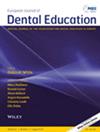关于使用牙科仿人机器人(SIMROID®)进行模拟实训的问卷调查
IF 1.7
4区 教育学
Q3 DENTISTRY, ORAL SURGERY & MEDICINE
引用次数: 0
摘要
导言:牙科仿人机器人 SIMROID® 能够复制人类特有的动作,可用于与患者交流和应对突发状况的培训。材料与方法 共有 112 人参加了调查,其中包括 50 名来朝日大学牙科学院参加校园开放活动的高中生、42 名朝日大学牙科学院四年级学生以及 20 名来自墨西哥州立自治大学、锡耶纳大学和北京大学的牙科学院学生。参与者观察了大约 20 分钟放置在牙科设备上的 SIMROID® 机器人的动作和反应,然后填写了一份问卷调查。调查问卷分为日语和英语两个版本,分别针对本地和来访的外国牙科学生。调查问卷包括 8 个项目,其中还有两个项目是针对正在接受牙科培训的学生的,另外还有一个开放式的意见栏。结果所有观察过 SIMROID® 的参与者都填写了调查问卷,回复率为 100%。总体而言,所有参与者都对使用 SIMROID® 进行模拟训练给予了高度评价。高中生对 SIMROID® 的综合评价为 4.56 ± 0.50 分,美国大学学生为 4.05 ± 0.82 分,外国牙科学生为 4.70 ± 0.47 分,这表明所有参与者都对 SIMROID® 有非常积极的体验和印象。本文章由计算机程序翻译,如有差异,请以英文原文为准。
Questionnaire survey on hands‐on simulation training using a dental humanoid robot (SIMROID®)
IntroductionA dental humanoid robot, SIMROID® , is able to replicate the actions characteristic of human beings and enable training for communicating with patients and coping with unexpected situations. This study assessed user experiences via a survey questionnaire following hands‐on training on the SIMROID® .Materials and MethodsA total of 112 participants, consisting of 50 high school students who visited AUSD (Asahi University School of Dentistry) to participate in open campus events, 42 fourth‐year students at AUSD and 20 dental students from Mexico State Autonomy University, University of Siena and Peking University took the survey. The participants observed the movements and reactions of a SIMROID® robot placed on a dental unit for approximately 20 min after which they completed a questionnaire survey. Both Japanese and English versions of the questionnaire were prepared for local and visiting foreign dental students. The questionnaire comprised 8 items, with a further two items for those undertaking dental training and an open comment field.ResultsAll participants who observed the SIMROID® completed the questionnaire giving a 100% response rate. Generally, simulation training with SIMROID® was highly appreciated by all participants. The comprehensive evaluation score for SIMROID® was 4.56 ± 0.50 points for high school students, 4.05 ± 0.82 points for students at AUSD and 4.70 ± 0.47 points for foreign dental students, showing all participants had a very positive experience and impression of the SIMROID® .ConclusionsTherefore, simulation training using SIMROID® seems beneficial learning tool.
求助全文
通过发布文献求助,成功后即可免费获取论文全文。
去求助
来源期刊
CiteScore
4.10
自引率
16.70%
发文量
127
审稿时长
6-12 weeks
期刊介绍:
The aim of the European Journal of Dental Education is to publish original topical and review articles of the highest quality in the field of Dental Education. The Journal seeks to disseminate widely the latest information on curriculum development teaching methodologies assessment techniques and quality assurance in the fields of dental undergraduate and postgraduate education and dental auxiliary personnel training. The scope includes the dental educational aspects of the basic medical sciences the behavioural sciences the interface with medical education information technology and distance learning and educational audit. Papers embodying the results of high-quality educational research of relevance to dentistry are particularly encouraged as are evidence-based reports of novel and established educational programmes and their outcomes.

 求助内容:
求助内容: 应助结果提醒方式:
应助结果提醒方式:


